|
< Earlier Kibitzing · PAGE 2 OF 2 ·
Later Kibitzing> |
| Nov-09-04 | | Calli: Euwe recommended 16...Qc8. But perhaps Reshevsky was afraid Bxh6 then or later. |
|
| Feb-24-05 | | chess man: Beautiful endgame play displayed by Smyslov. |
|
Jun-11-06
 | | LIFE Master AJ: In my own opinion, not only is this great endgame play by Smyslov, it might go down as one of the "Ten Greatest R+P endings of all time." ---> At the time that this game was played, endgame theory generally considered the endgame of "Four versus two," with an outside Passed QRP (for Black) ... to be drawn. This exceptional ending is analyzed in my "Endgame School." (http://www.angelfire.com/games4/lif...) |
|
| Jun-11-06 | | CapablancaFan: <LIFE Master AJ: In my own opinion, not only is this great endgame play by Smyslov, it might go down as one of the "Ten Greatest R+P endings of all time."> This was a good R+P endgame, but the greatest? I believe this game is probably the best. Capablanca vs Tartakower, 1924 |
|
Jun-11-06
 | | Pawn and Two: A very well played and instructive game by Symslov.
Reshevsky attempted to improve on the opening from Rd 1, Euwe - Keres. In that game Keres played 12...exd4 13.Nxd4 Re8. Euwe had a small advantage in this position. However, Reshevsky's 12th move is inferior to 12...exd4. Golombek explains in the tournament book that Reshevsky's 12...Re8 is incorrect, because White can now exchange with advantage. At move 15, Golombek indicates that 15...Na5 was better. At move 16, Golombek states: <And now he should have tried 16...Qc8; however, his position is already precarious> The resulting Rook and Pawn endgame, was considered to be clearly winning for White at the time this game was played. In the tournament book, Golombek states after 26.Qh4: < An ingenious move that forces the win of the Q Pawn, and of the game, despite Reshevsky's subsequent wriggles> At move 31, Golombek states: <Equally fatal is 31...Nxe4 32.Rxe6 Ng5 33.Re7 Rc6 34.Be3> After move 36, Golombek states: <The Rook and Pawn ending is hopelessly lost for Black, and Smyslov condusts it in mercilessly accurate fashion.> After White's 38th move, Golombek states: <The winning method is limpidly clear: the King must usher the K side Pawn majority down the board> After Black's 41st move, Golombek states: <The sealed move; Black could also quite tranquilly resign. He cannot shut out the white King by 41...Ra6, since then White plays first f3 and then Kg3-Kf4 and Pe5.> Golombek also relates the following about the ending of this game: <...when the game was adjourned on the 41st move Reshevsky had a clearly lost Rook and Pawn ending. On resumption of play, Reshevsky was quite surprised to see the hall once more full with some 2,000 spectators anxious to see the end of the game. Reshevsky asked Kotov why so many people had come to watch a spectacle that could only be brief and not particularly instructive. Kotov replied that Reshevsky was well known for his resoucefulness in critical situations, and they wanted to see what he could do when faced with such a difficult problem. But the American Champion said mournfully that this time it was too late for any tactical jokes, and so it proved, for the game lasted only another nine moves, Smyslov finding the simplest and most forceful finishing touch> |
|
Jun-12-06
 | | LIFE Master AJ: <CapaFan>
Please notice that I said one of the top ten or ten greatest of all time. Anyone familiar with my work or my web pages knows I have annotated the game that you refer to ... and consider it (also) to be one of the ten best. (A personal favorite ... aand maybe the greatest ever.) |
|
| Jun-12-06 | | Marmot PFL: I have to agree with Reshevksy here- playing over the game and choosing white's next move I found the rook ending rather easy. Smyslov found some very nice midgame moves to exploit Reshevsky's dubious opening (often his weakness). Considering that white had an edge in both space and development as well as the bishop pair against two knights it would be surprising if Smyslov didn't win. |
|
Jun-12-06
 | | LIFE Master AJ: I should qualify my last post.
I consider the R+P endgame phase of Capa-Tartakower, 1924 ... to be perhaps the greatest ROOK-plus-PAWN endgame ever played. (Its also a personal favorite.) |
|
| Jan-04-08 | | Dr. Siggy: In the exciting <The World vs Gert Jan Timmerman> challenge, promoted by <chessgames.com> in 2007, the following (possible) rook endgame was indicated (by me) as a winner for White: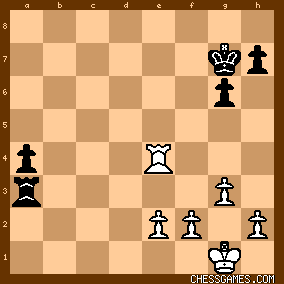
click for larger viewAs I have stated, this is "[...] a well known 'book win': an active Rook and two (future) connected passed pawns against a passive Rook and one passed pawn." And, to support my statement, I have pointed out Reuben Fine, "Basic Chess Endings", New York 1941, pages 353 sqq.. To my complete astonishment, an experienced correspondence chessplayer, in page 957 of the main forum of <The World vs Gert Jan Timmerman> game, has thrown doubts over my statement and Fine's teaching. Since it may be of use to less experienced chessplayers, I leave here a proof that both Fine and I were right - a proof given by none other than the former World Chess Champion, Vassily Smyslov. The position over the board after Black's 37th move is as follows: 
click for larger view“The White pawn mass on the Kingside puts an end to Black’s desperate resistance” (Kasparov). To whom may be interested, another very good proof of my statement, taken out of recent praxis, is <Motylev vs Brodsky, Bucarest 2001>. |
|
| Sep-06-10 | | andreagiananti: why does black develop the king knight to e7 in the opening? This looks really passive. Is it an old fashioned line? |
|
| Mar-03-12 | | PinnedPiece: GTM Score=108 Par=91
I made many moves in the last 10 that were not Smylov's but got credit anyway. Example: on the last move I played Kxg7 rather than Ra7+. Got full credit. . |
|
Jun-03-20
 | | fredthebear: Perhaps a dozen sources have published this game, primarily due to Smyslov's technique in the Rook and pawns ending. |
|
| Oct-14-23 | | rmdalodado: This is given as Game # 42 in Chernev's The Golden Dozen, Game # 31 in Smyslov's My Best Games of Chess (1935-1957) and Game # 17 in Smyslov's 125 Selected Games. |
|
Jul-07-24
 | | plang: In the first round Keres had played 12..exd against Euwe and had gone on to win; 12..Re8? was new but quickly proves inferior to Keres' move after 13 dxe! Uhlmann after 14..dxe:
"...Black had to open the d-file, since 14..Nxe5 would be unfavourable in view of a later f2-f4. The opening of the d-file benefits White since he can be the first to occupy the file with a rook. White's possession of the bishop pair is a factor in his favour, on account of their greater scope. The white knight on d5 is another point in White's favour. Black is unable to find a good square for hs queen. Thus Black also suffers from a lack of space, and tactical possibilities arise on the d-file." 16..Qc8 would have been passive but might have been an improvement in a bad position. Another example of the "simplicity" of Smyslov's play though 26 Qh4! is quite pretty. |
|
Dec-19-24
 | | KEG: An absolutely superb game by Smyslov that ultimately player a major role in his managing to finish 2nd in this World Championship tournament, a half-point ahead of Reshevsky and Keres. Smyslov was always a tough opponent for Reshevsky. The latter won a game against Smyslov in 1939 but then failed to take another game from the Russian for the next 31! years, losing twice to Smyslov in the 1945 USSR-USA Radio match, losing this game while drawing his other four games in this 1948 event, and then beating Reshevsky yet again in the 1953 Zurich candidates; tournament while drawing their other eleven games before splitting games in the 1970 USSR vs. the World event. Of course, Smyslov was always a tough opponent for just about everybody, not just Reshevsky. The present game showcases Smyslov's profound opening knowledge as well as his fabulous end-game technique. His handling of the Rook and Pawn ending here is a classic! Reshevsky made the mistake here of--yet again--trying an opening against Smyslov in which the latter was better prepared. I should also mention the detailed analysis of the present game in the recent book by Andrey Terekhov, which reviews most of the earlier commentaries on this game and has made important new discoveries. Any consideration of this game must now begin with what Terekhov has found and reported. 1. e4 e5
2. Nf3 Nc6
3. Bb5 a6
4. Ba4 d6
This deferred variation of the Steinitz Defense to the Ruy Lopez got a major workout in the early rounds of this tournament. Reshevsky should have expected that Smyslov would be fully verses in the complexities of this opening. This game was played just after the scene shifted from the Netherlands to Moscow after a break of more than two weeks, so Smyslov had ample time to prepare, especially after Reshevsky had just tried--and nearly lost--to Euwe in the final round played in the Netherlands. Smyslov would obviously be prepared for an opening variation Reshevsky had already played twice before in this tournament/ I have already commented on the prior games in which this line was played at this tournament [Euwe--Keres, Round 1 (0-1); Keres--Reshevsky, Round 8 (1/2-1/2); and Euwe--Reshevsky, Round 10 (1/2-1/2)]. 5. c3
Keres had played 5. c4 in his 8th round game against Reshevsky. 5... Nge7
Keres had played 5...Bd7 and then 6...Nge7 against Euwe, transposing into what occurred to that point in this game. 6. d4 Bd7
7. Bb3
Euwe had surprised Reshevsky in their 10th round game with 7. h4 here. Smyslov, no doubt expecting Reshevsky to be well verses in that variation reverted to the move Euwe had played in Round 1 versus Keres. 7... h6
8. Nbd2 Ng6
9. Nc4 Be7
10. 0-0 0-0
11. Ne3

click for larger view11... Bf6
Repeating the move Keres had played against Euwe in Round 1. At the end of 1948, the same position was reached at the 1948 USSR Championship in a game between Bronstein and Keres in which the latter played 11...Re8. Most of the commentators follow Keres in preferring 11...Re8 to the move Reshevsky played here. Actually, both moves--and 11...exd4 for that matter--are all decent tries, White obtaining small but decided edge in any case. 12. Nd5
Euwe's move in his first-round game against Keres. 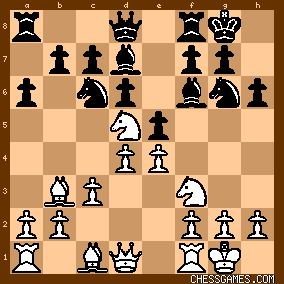
click for larger viewBoth players must have had this position on their boards at home in preparing for this game. Keres had played 12...exd4 here and managed to win even though Euwe to this point was better. Reshevsky, as we will see, had prepared a new idea here which he no doubt thought was an "improvement." As it turns out, Smyslov was apparently prepared to the hilt for Reshevsky's novelty which--though not bad as a theoretical matter, back-fired against the rock-solid play of Smyslov. |
|
Dec-19-24
 | | KEG: Post II
12... Re8
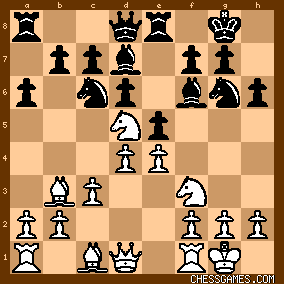
click for larger view"?"--(Karparov)(Terekhov)
The commentators are unanimous in condemning this move and in claiming that it was inferior to 12...exd4 (Keres' move). For example: "Keres played 12...exd4, but, as his success was due only to his opponent's collaboration, Reshevsky's move must be viewed as an attempt to improve the variation for Black. The attempt fails" -- (Kmoch) "...Reshevsky tries to improve on [Keres' 12...exd4]. But in actual fact 12...Re8 is much weaker and gives White an excellent attack and the Bishop pair, while Black is not getting any compensation in return"--(Keres) "In trying to strengthen the variation, Black makes a serious mistake..." -- (Kasparov) "In choosing the text move Reshevsky thought he was strengthening the whole variation, but White by his simple reply gains a positional advantage"-(Smyslov) There is no denying that White obtains an edge after Reshevsky's move. But, in fairness, Black would also have a slightly inferior game after 12...exd4. Given what happened to Keres against Euwe when he played 12...exd4, Reshevsky can hardly be blamed for trying something new. As a theoretical matter, the text is not all that much worse for Black than is 12...exd4. What DID happen is that Reshevsky ran into the very sort of player in Smyslov best equipped to exploit his small but noticeable edge. In this regard, Smyslov's play from this point reminds one of Capablanca in his ability to make simple move that slowly crush the opponent. Given Smyslov's profound understanding of this opening, he slowly but surely outplayed Reshevsky from this point. With the exception of his remarkable 26th move (that was not in my mental data-base), none of Smyslov's punishing moves was all that brilliant. On the contrary, everything seems logical and simple (all al a Capablance). 13. dxe5
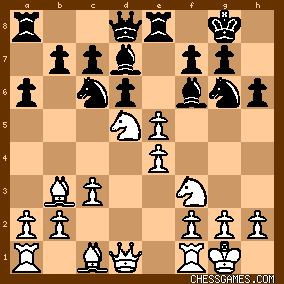
click for larger view"!"--(Golombek)(Kmoch)(Euwe)(Keres)(Smyslov)(Terekhov) As all of the commentators have pointed out, Smyslov's move forced Reshevsky to recapture with a piece since 13...dxe5? Would now lose a pawn after 14. NxB+ since Reshevsky could not recapture with his Queen because then his Knight on d7 would be hanging, thus allowing White after 13...gxN [forced] to grab the Black h-pawn with 14. Bxh6 thereby obtaining a clear winning position. 13... Bxe5
The commentators all closely considered 13...Ngxe5 and (rightly) concluded that it would have been inferior (albeit only marginally) to the text. The continuations would certainly have been interesting: 14. NxN NxN [14...BxN and 14...RxN are no better] 15. f4 Nc6. From here, the commentators had all opted for 16. e5 claiming this would give White a crushing attack, but this attack, as Kmoch and now Terekhov have shown) is not as powerful as had been believed: 16...Be7 [not 16...dxe5?/ 17. NxB+ as pointed out by Kasparov] 17. Qh5 Be6 18. Be3. But here, as Terekhov has noted, Black can hold his own not with 18...dxe5 as analyzed by Kasparov and others which leads to an overwhelming position for White after 19. Rad1, but rather with 18...Qd7! The flaw in the above analysis, as spotted first by Kmoch and more recently by Terekhov, is that White, instead of 16. e5, should play 16. Bc2!, pretty much forcing Black to play 16...g6. But now, instead of Terekhov's 17. Qd3 allowing Black to regroup with 17...Bg7 with a likely defensible position, White could here play 18. e5 Bg7 18. exd6 cxd6 19. f5! leaving Black a difficult defensive task. But everybody seems to miss Black's best: 13...Ncxe5 14. NxN RxN with an only slightly inferior position. After Reshevsky's actual move (13...Bxe5), Smyslov was able to obtain the advantage of the two Bishops with: 14. NxB
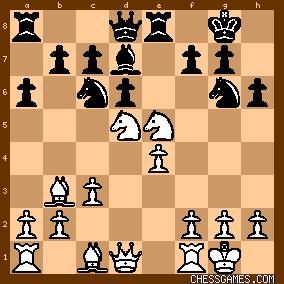
click for larger view"...not only does White have the advantage of the two Bishops, but...he acquires this whilst retaining his powerful Knight on d5 , thereby ensuring him the command of the center"--(Golombek) "White takes the Bishop with his King Knight, nit with his dominating Queen Knight--an important difference from the Euwe-Keres game"--(Kmoch) How now should Reshevsky recapture on e5? |
|
Dec-20-24
 | | KEG: Post III
14... dxN
Kasparov and Terekhov both claim that 14...NgxN was the "lesser evil." Kmoch, by contrast, assigned a "?" to 14...NgxN. In fact, White emerges with the better game whatever Reshevsky plays here. But let's consider the merits of 14...NgxN: Kasparov, contra Kmoch and Terekhov, gives 15. h3 as White's best here. This is a significant improvement on Kmoch's proposed 15. f4, since after Kmoch's move Black plays not 15...Ng6 as Kmoch suggests but rather 15...Ng4! [Kasparov's improvement] with better chances for Black than in the game. If White then plays 16. e5?! Black can get fine counter-chances with Terekhov's 16...Na5. If instead White continues with 16. Qf3 as per Terekhov, then again Black is not so bad at all after 16...Na5 17. Bc2 dxe5 since then 18. f5 is answered with 18...h5 19. h3 Bc6 20. hxN QxN 21. QxQ BxQ 22. gxh5 Rad8 Black has a tougher nut to crack if 14...NgxN is answered by Kasparov's 15. h3. Now after 15...Be6 White does better than Kasparov's 16. f4 Nd7 with the subtle 16. Bc2. This is not much better for Black than what transpired in the game. Probably best for Black is the move only Terekhov suggests: 14...NcxN. Now the only way White can seek any meaningful edge is with 15. f4 [as Terekhov shows, 15. h3 allows Black to equalize with 15...Bb5!] Ng4 [anything else is bad] 16. h3 [better than Terekhov's 16. Qd3 which runs into strong counter-play by Black with 16...a5 followed by 17...a4] Nf6 17. e5 ("!>"--Terekhov] NxN 18. QxN Be6 19. Qxb7 BxB 20. axB dxe5 21. f5 Nf4 22. BxN exB 23. RxB "and Black has good counter-play for the pawn"--Terekhov. I give the above lengthy variation not because one would expect even Reshevsky to divine all this over the board, but rather to show the difficult problems with which Smyslov confronted Reshevsky in this game while he continued to play the sort of clear, simple moves that would likely have appealed to Capablanca. The position after Reshevsky's 14...dxN was:
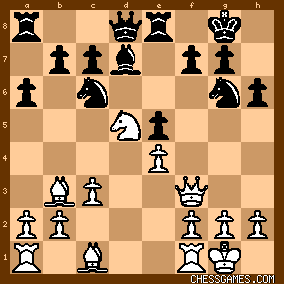
click for larger view15. Qf3

click for larger view"With the threat of Rd1"-(Golombek)
"White has a clear advantage: the Bishop pair, a strong Knight, and generally great freedom of play"--(Euwe) "White's advantage is determined: his Knight on d5 dominates the center and this is still further increased by the open d-file. As well as this, White has two active Bishops"--(Smyslov) "Black's position is worse than it looks at first glance"--(Terekhov) Smyslov had accomplished all this without Reshevsky having committed another close to a blunder or any sort of serious mistake. Sammy now had to solve increasingly difficult problems to try to keep his head above water. 15... Be6
"?"--(Keres)
"The beginning of a faulty plan..."--(Keres)
Golombek, Euwe, and Keres all claimed 15...Na5 would have been a significant improvement. But Smyslov argued otherwise. After 15...Na5 16. Bc2 c6 [16...Be6 and then 17...c6 is no better--KEG] 17. Ne3 Be6 18. Nf5 [better than Keres' 18. Rd1 Qc7--KEG] Qc7 [perhaps 18...c5 or 18...Nc4 would be superior tries for Black who even then would be gasping for air--KEG] 19. Qg4 [White's position is so good he can probably just play 19. g3 here with excellent winning chances--KEG] after which Black is in serious trouble. He would have nothing better here than 19...Qd8 (which looks awful). The alternative of 19...Kh7 would run into 20. h4 as given by Smyslov. All in all, I must agree with Smyslov here: 15...Na5 would not have been an improvement. But after Reshevsky's 15...Be6, which was about as good as anything ("He wishes to rid himself of the strong Knight at d5"--Smyslov), Black's position remained in perilous straits: 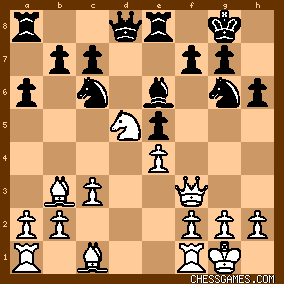
click for larger view |
|
Dec-20-24
 | | KEG: Post IV
16. Rd1
"!"--(Kmoch)
"Threatening 17. Bxh6 gxB 18. Nf6+"--(Kmoch)
16... BxN
"?!"--(Terekhov)
It is understandable that Reshevsky wanted to rid himself of the intruding Knight on d5. But here the remedy proved worse than the disease. Best is probably 16...Qc8 as recommended by most of the commentators though, as Golombek aptly said, "his position is already perilous." <Cali said that perhaps Reshevsky feared 17. Bxh6 after 16...Qc8, but this blows all of White's edge: 16...Qc8 17. Bxh6?! gxB 18. Nf6+ Kg7 after which White has nothing better than a perpetual check with 19. Nh5+ Kf8 20. Qf6 BxB 21. Qg7+ Ke7 22. Qf6+. Kmoch called the text "a grave concession," and Terekhov labeled it "a premature exchange," but both agreed that even after the "superior" 16...Qc8 Black would still be in a difficult position after 17. h3. While 16...Qc8 is probably Black's best try here, it is hard to disagree with Keres that "This exchange is sooner or later forced." After Reshevsky's 16...BxN, the position was:
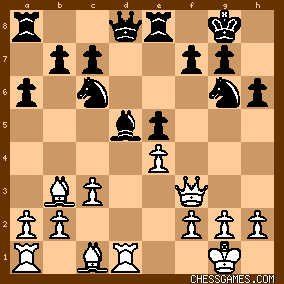
click for larger view17. RxB
"!"--(Golombek)(Terekhov)
"Complete comfort"--(Kasparov)
"White's initiative increases all the time. Now the Rook occupies an active position in the center of the board"--(Smyslov) "...White maintains a clear positional advantage with no risk." The commentators all agree that 17. exB would needlessly allow Black counter-play after 17...e4. 17... Qe7
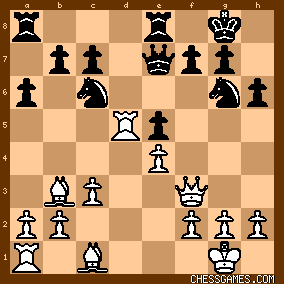
click for larger view18. Qf5
"!:--(Kmoch)(Keres)(Smyslov)(Kasparov)
"Threatening 19. Rd7"--(Kmoch)[accord--Smyslov)
"White's pieces arrive at the best squares with impressive efficiency..."--(Terekhov) Remarkably, none of the commentators mentions the most natural (and probably best) alternative: 18. Be3. The only eyesore in White's position is his still undeveloped dark-square Bishop. In addition to being a natural developing move, 18. Be3 threatens Bc5. In any case, even if not the absolute best move, Smyslov's 18. Qf5 was a strong maneuver and left Black's position in great danger: 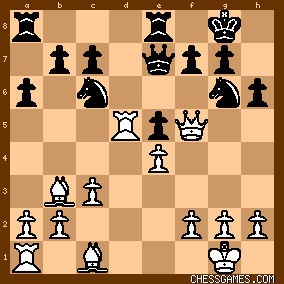
click for larger view18... Nf8?
Nearly all of the commentators claimed that this ugly move was forced ["the only move"--(Kasparov)]. They pretty much all discounted 18...Qe6 [18...Rad8? loses to 19. Bxh6! RxR (best) 20. exR Nd8 (best) 21. Be3] on the assumption that it would lose instantly to 19. Rd7. But Terekhov has revealed a "nifty trick" by which Black then saves himself by 19...QxQ 20. exQ and now the "nifty" and surprising 20...Re7 and suddenly Black is back in the game. This 18...Qe6 was Black's best, and perhaps his last chance to save the game. 19. Be3
"Threatening Bc5"--(Terekhov)
19... Ne6
"Protecting the Queen against Bc5..."--(Kmoch)
Perhaps 19...Rad8 20. Bc5 Qf6 was marginally better. After 19...Ne6, the position was:
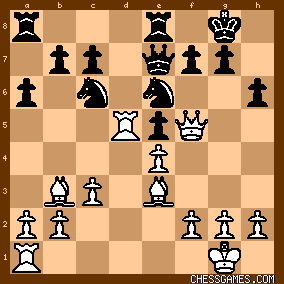
click for larger view |
|
Dec-22-24
 | | KEG: Post V
20. Rad1
"White is playing a boa-constricting type of game which will be familiar to the students of the masterpieces of Rubinstein. All useful squares are to be taken away from Black until the unfortunate dies of suffocation"--(Golombek) 20... Red8
"?"--(Euwe)
Euwe [whose "?" seems out of line] and Golombek prefer 20...Rad8. Golombek gives a lengthy explanation for this preference, only part of which I will quote here: "As later becomes apparent [when the Black a8 Rook becomes bottled up after 24...Nb8], it is the Queen's Rook that should go here...it is rather surprising that Reshevsky should err here, as he has already centralized his King's Rook. Possibly he has in mind the eventual maneuver Qe1 followed by Ne7, but he never manages to achieve it." Kmoch, by contrast, prefers the text, calling it: "A little more economical than 20...Rad8, for the King Rook lacked play at e` and hampered the Queen." Given the positional superiority Smyslov had already achieved, Black would have been in great difficulties no matter which of his Rooks went to d8. I therefore see no strong preference between Rad8 and Red8. The text left:
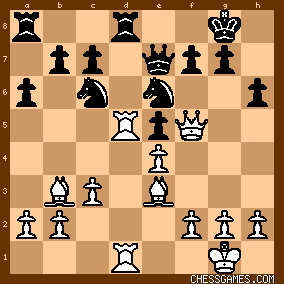
click for larger view21. g3

click for larger view"Not just a shelter for the King. White prepares the possibly important advance f4"--(Kmoch) "There is no hurry, and for now White restricts the mobility of the enemy Knights"--(Kasparov) All true, but the best commentary on 21. g3 comes--not surprisingly--from Smyslov himself: "White takes advantage of the immobility of Black's pieces to strengthen his position and limit the activity of the enemy Knights. Black has no counterplay..." 21... Rd6
"Black has no entirely satisfactory move here, and therefore saddles himself with a badly backward d-pawn so as to get rid of one of the major pieces"--(Golombek) The drawback of the text was commented on by nearly everybody was wrote about this game: "In trying to reduce the pressure on the d-file, Reshevsky allows the creation of a backward pawn"--(Kasparov) As unpleasant as the text was, it appears that everything else was worse: (A) 21...g6, as Golombek pointed out, loses a pawn: 22. RxR+ RxR [22...NcxR, not mentioned by Golombek, might be less immediately disastrous than 22...RxR, but it too loses a pawn after 23. Qxe5; while 22...NexR results in catastrophe after 23. Qxg6+] 23. RxR+ QxR [Knight recaptures fail as on move 22 above] 24. Qh3 (B) 21...Nf8 loses to 22. Bc5 leaving Black numerous ways to get crushed: (i) 22...Qe8 23. BxN KxB [or, even worse, 23...QxB 24. Rd7] 24. Rd7 RxR 25. RxR Ne7 26. Qg4 Rc8 27. Bxf7 QxB 28. RxN KxR 29. QxR; (ii) 22...Qf6 loses to 23. RxR [23. QxQ immediately also wins] RxR 24. RxR NxR 25. Qc8; (iii) 22...Qe6 gets crushed after 23. RxR; while (iv) 22...Qg5 loses to 23. RxR NxR 24. RxN!; (C) 21...Qe8 [perhaps the best try[ loses to 22. RxR RxR [best] 23. RxR NexR [best] 24. Qc8 Qe7 25. Bd5 (D) 21...Kh8 loses to 22. RxR+ RxR 23. RxR+ NexR [forced[ 24. Bd5 after which White's Bishops are too strong. In sum, Reshevsky's 21...Rd6, despite its obvious drawbacks, was the best chance. It left: 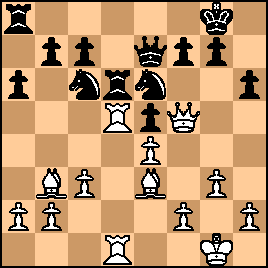
click for larger view22. RxR
"Chess is the art of exchanging--this move closes the d-file, but creates a backward pawn in Black's camp, which Smyslov immediately sets to attack"--(Terekhov) 22... cxR
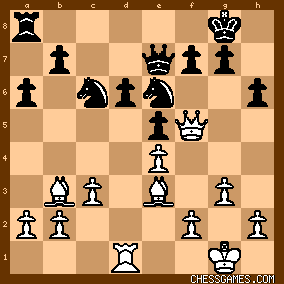
click for larger view |
|
Dec-25-24
 | | KEG: Post VI
23. Qg4
"!"--(Kasparov)(Terekhov)
"With the obvious threat of Bxh6." (Kasparov)
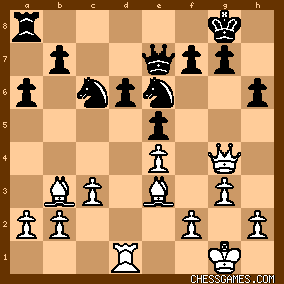
click for larger view23... Kh8
"?"--(Kmoch)(Keres)
"Making his bad position worse"--(Kmoch)
"Removing the King from the battlefield will later cost Black dearly"--(Keres) As noted by Terekhov, almost all of the commentators opined that 23...Kf8 was correct. But this notion was rejected by Golombek ("23...Kf8...leaves the King foo exposed after White has exchanged off on e6") and--in more detail by Smyslov, who gave the followed line after 23...Kf8: 24. Bb6 Nc7 25. Qf5 [25. Qe2 is the computer move--KEG] Ne8 26. Qh7 [now possible with the Black King on f8]. But here Smyslov's 26...Nf6 is a mistake [as pointed out by Terehov] as it gets crushed by 27. Qh8+ 28. Rd3 while in fact Black might have a prayer of holding on with Terekhov's 26...Qf6! Given the improvement discovered by Terekhov, the old consensus preference for 23...Kf8 does indeed appear to be Black's best chance of surviving. After Reshevsky's actual 23...Kh8, the position was: 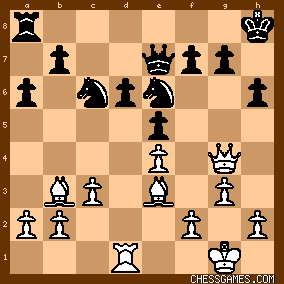
click for larger view24. Bb6
"!"--(Kmoch)(Smyslov)(Kasparov)
The multiple merits of this move have been well-explained by the commentators: "Threatening Rd2 followed by Qd1"--(Golombek)[See similarly Euwe and Kasparov) "Stopping ...Na5 and ...Rd8, and creating a potential threat, Bc7"--(Kmoch) Summing up:
"Depriving the Black Rook of the square d8 and preparing to double the heavy pieces on the d-file"--(Smyslov) 24... Nb8?
"?"--(Golombek)(Kmoch)(Keres)(Terekhov)
This move is unimaginably ugly, as a glance at the board reveals: 
click for larger viewReshevsky's idea, as pointed out by Golombek and Euwe, was to play Nb8-d7-f6-e8 and thereby defending the d6 pawn. But this idea was far too slow and runs into an immediate refutation by Smyslov that wins a pawn and ultimately the game. But while it is easy to mock the text, finding a decent move for Black is highly problematic. The various remedies suggested by the commentators all likewise seem to lead to disaster for Black. (A) 24...Rf8 leads to trouble after 25. Rd2 [25. Qe2 is also very strong here for White] and now 25...Nc7 (best) runs into 26. Qd1 Ne8 after which White secures a crushing find on the position with 27. f3 [even better than the oft-suggested 27. Bd5. (B) 24...Rc8 superficially like the best chance to avoid material loss, but this too is no great panacea: 25. Rd2 [piling up on the Black d-pawn] Nb8 (what else?) 26. BxN [even better than 26. Qd1] fxB 27. Qd1 Nd7 28. Rxd6 NxB 29. RxN again leaving White a pawn up with plus a strong bind on the position. (C) 24...Kg8 only delays the inevitable and does nothing to prevent White from slowly crushing the Black position; (D) 24...Nc7 25. Qf3 [en route to d3] Rf8 (pretty much forced) 26. Qd3 Na8 [a sad necessity] 27. Be3 Rd8 [forced] 28. Bd5 leaving Black in a bind in which he will soon be forced to lose a pawn. In sum, easy as it is to despise Reshevsky's ugly move, the sad fact was that Reshevsky was in trouble no matter what he did. As my next posts will show, Smyslov after 24...Nb8 was able to unleash a winning sequence to which there was no defense. But as the sequel will also show, Sammy--though theoretically lost--fought hard to maintain counter-play and to put as many obstacles as possible in front of the Smyslov bull-dozer. Among other things, Reshevsky's stubborn resistance required Smyslov to win a classic Rook-and-Pawn ending, and provided the latter with an opportunity to display his superb end-game technique. |
|
Dec-26-24
 | | KEG: Post VII
25. BxN
"!"--(Kmoch(Kasparov)
"Beautiful play"--(<Helloween>) As Smyslov quickly demonstrates, this wins by force. 25... fxB
"Otherwise 26. QxQ wins two pawns at once"--(Kmoch) This left:
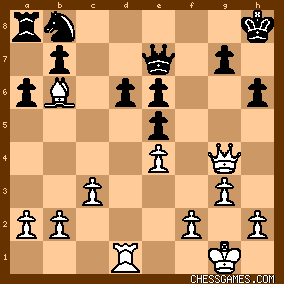
click for larger viewWhite to play and win.
Although the winning move is not any sort of traditional brilliancy, it is somewhat counter-intuitive and--I must confess--did not jump out at me when I first played over the game: 26. Qh4!
"!"--(Golombel)(Euwe)(Smyslov)(Keres)(Kasparov)(Terekh-
ov)
"!!"--(Kmoch)
"What Reshevsky had overlooked"--(Kmoch)
"An ingenious move that forces the win of the d-pawn and of the game despite Reshevsky's subsequent wriggles"--(Golombek) "With this excellent move, White uses the temporary weakness of his opponent's back rank and wins the d6-pawn by force. And this signifies the end of the game"--(Keres) "A problem move that seals the fate of d6"--(Euwe) "A splendid move, winning the d6-pawn, and with it the game"--(Kasparov) "An astounding solution. It is difficult for humans [even to] consider such a counter-intuitive move, and one also has to notice the unusual follow-up idea that we will see next"--(Terekhov) Voluntarily allowing Black to saddle White with doubled pawns on the h-file is indeed "counter-intuitive", until the move is considered. As Dvoretsky has shown, 26/ Qf3 also wins. But the text is the fastest, most direct, and most aesthetically satisfying (in my view) way to clinch the win. 26... Qd7
If instead 26...Qxh4, then White romps after 27. gxQ Nd7 (best) 28. Rxd6 Nf8 [28...NxB 29. RxN is even worse for Black. After 26...Qd7, the position was:
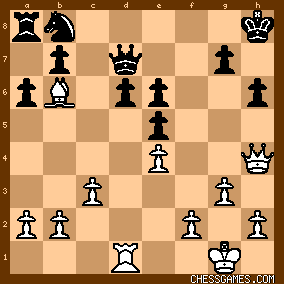
click for larger viewOnce again, White to move and win:
27. Qd8+
"!"--(Kmoch)
"Taking full advantage of the temporary weakness of Black's first rank"--(Kmoch) "White goes for the simplest way: now he will win at least a pawn in a good position"--(Euwe) "The harmonious co-operation of pieces behind the enemy lines, resulting logically from systematic strategy, is rare in practice"--(Smyslov) 27. Bc5 also wins, but the text is the killer.
27... QxQ
28. BxQ
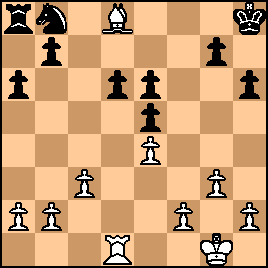
click for larger view28... Nd7
"The Queen Pawn is lost anyway; e.g.. 28...Nf6 29. Bb6"--(Kmoch) "With his following moves, Black attempts desperately to avoid the loss of a second pawn"--(Kmoch) Black is lost, true, but as will be seen Reshevsky valiantly sought counter-play and made Smyslov's task as difficult as possible. The text (28...Nd7) was definitely his best chance to resist. 
click for larger view |
|
Dec-26-24
 | | KEG: Post VIII
29. Bc7
"?!"--(Terekhov)
As apparently only Terekhov has noticed, 29. Ba5 was even stronger: 29. Ba5 b5 30. Rxd6 Nc5 31. Rc6 Nxe4 32. Kg2 [the e6 pawn will not run away--KEG] Rf8 33. Bb6 Nf6 34. Be3 Ra8 [there is nothing better] 35. Rxe6 leaving White a pawn up and Black still in a horrific bind. In fairness to Smyslov, however, his move also wins. It left: 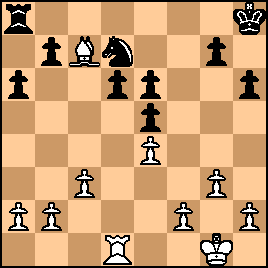
click for larger view29... Nc5
This was Reshevsky's best try. If instead 29...Nf6 then White wins after 30. Rxd6 Rc8 31. Bb6 Nxe4 32, Rxe6 Rc6 33. Re8+ Kh7 34. Be3 leaving White a pawn to the good while still holding a bind on the Black position. If instead 29...Rxf8 White wins with ease after 30. Bxd6. 30. Rxd6
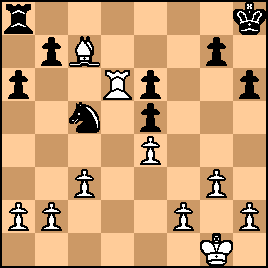
click for larger view"The loss of the d6-pwn means the end of the game. Although Reshevsky subsequently puts up stubborn resistance, his position is to ruined that it has no hope of success"--(Keres) The game is now theoretically a clear win for White, but it is nonetheless noteworthy to see the clever ways Reshevsky manages to create problems for Smyslov and also to observe Smyslov's endgame technique in closing out this game. 30... Rc8
"!"--(Terekhov)
"...Black [has] finally managed to develop all of his pieces and he is only a pawn down, so White still has work to do"--(Terekhov) "After 30...Nxe4 or 30...Na4 there follows 31. Rxe6 and Bxe5"--(Keres) There is no doubt that Reshevskys 30...Rc8 was his best means of offering resistance. 31. Bb6
Yet again, as per Terekhov, 31. Ba5 was even more brutal. But the text was also good enough to preserve White's winning advantage, the position now being: 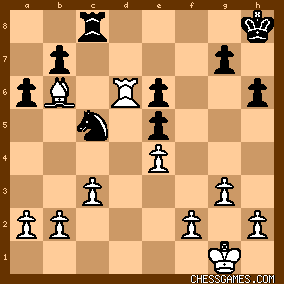
click for larger view31... Na4
"Or 31...Nxe4 32. Rxe6 and White's task is even simpler"--(Keres) Play could then continue [following up on Keres' line] 32...Rc6 [better than Golombek's proposed 32...Ng5] 33. Re8+ Kh7 34. Be3 Nd6 [there is nothing better] 35. Rxe5 Nc4 36. Re7 and White is two pawns up with an easy win. Reshevsky's 31...Na4 was thus by far the best attempt available to Black. 32. Rxe6
32. b3 also works for White; e.g., 32...NxB 33. RxN Rxc3 34. Rxb7 with a possibly easier win than with Smyslov's 32. Rxe6. 32... Nxb2
The computers prefer 32...Kg8 (keeping the Bishop under attack), but not even that move (which is not likely to occur to a human playing over the board) has much chance of saving the game. 33. Rxe5

click for larger view33... Nc4
33...Rxc3 would have been hopeless. White can then win with 34. Bd4 Rc1+ 35. Kg2 Nd3 [Golombek's suggestion, which seems better than Euwe's 35...Rc2] after which White wins with 36. Re8+ [even better than Golombek's 36. Re7 Kh7 and only now 37. Re7 and Black is dead, as pointed out by Terekhov]. The only plausible alternative for Black here is Terekhov's 33...Na4. Terekhov now claims that White must now play 34. Re6. But in fact 34. Bd4, contrary to what Terekhov has stated, not only does not lose a tempo but is the fastest route to victory: i.e., 34...Nxc3 35. Kg2! [avoiding nasty Knight forks] Rc4 36. BxN RxB 37. a4 and White with his extra pawn--including his protected passed e-pawn--should win. 34. Re6
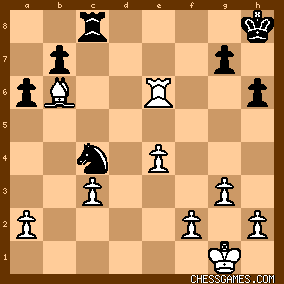
click for larger view |
|
Dec-27-24
 | | KEG: Post IX
34... NxB
Reshevsky here elected to reduce to a Rook and Pawn ending. As Smyslov soon demonstrates, Black has no chance in this endgame against best play by White. Terekhov concludes that Reshevsky here missed his "last practical chance," which he claims was 34...Kg8. Whether that was indeed the best "practical chance" can be debated (for what little it is worth, Fritz and Stockfish both play 34...Kg8 here). But neither move saves the game against strong play by White. But let's consider Terekhov's 34...Kg8. White would then be forced to play 35. f4 (anything else hangs the Rook and now it is Black who wins). Terekhov then gives 35...NxB as correct [if instead 35...Kf7 White wins after 36. f5 NxB (36...Rc6 37...Rc6 38. RxR bxR 39. Bc7 leaves Black two pawns down in the minor piece ending with no real chances at all] 36. RxN Rxc3 37. Rxb7 Rc1+ 38. Kg2 Rc2+39. Kf3 Rxh2 nabbing one of the White King-side pawns. But now White, though allowing Black to obtain material equality, wins with his monster e-pawn: 40. e5 Rxa2 41. e6 Kf8 and now White can play the crushing 42. f5 [even stronger than Terehov's 42. Rf7+ Kg8 43. f5 which also wins]. In sum, 34...Kg8 would not have saved the day for Reshevsky. So let's revert to the actual game in which Reshevsky quite reasonably played 34...NxB: 35. RxN Rxc3
36. Rxb7
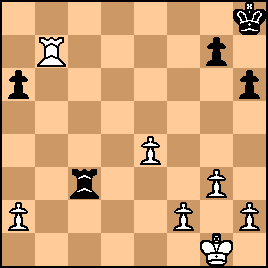
click for larger view36... Rc2
36...Ra3 37. Rb2 leaves Black two pawns down with no real chances at all. Reshevsky's move also threatens the White pawn on a2 and is more active. It left Smyslov at an interesting cross-road: 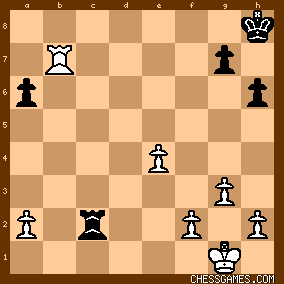
click for larger view37. h4
"!"--(Kasparov)
"!?"--(Terekhov)
Smyslov had various winning lines here. He might have played 37. a3 or 37. a4 and then gotten his e-pawn in motion which seems to win: e.g., 37. a3 Rc3 38. f4 with 39. e5 to follow or 37. a4 Rc4 38. e5. Alternatively, he could just have played 37. f4 and then 38. e5 getting his steam-roller going without delay. But Smyslov had another winning idea: He let Reshevsky grab his a-pawn but locked up the King-side eliminating Black's counter-play. Reshevsky might now have tried 37...Kg8 to bring his King into play, but then Smyslov could just have ignored the threat to his a-pawn and brought his King to support his advancing pawn phalanx with 38. Kg2. Given all this, Reshevsky decided to bite the bullet and played: 37... Rxa2

click for larger view"The Rook and pawn ending is hopelessly lost for Black, and Smyslov conducts it in mercilessly accurate fashion"--(Golombek) "White finally has but one Pawn play, but he wins in a walk"--(Kmoch) "White's passed pawn in the center speedily decides"--(Keres) "By defending tenaciously, Reshevsky has avoided a rapid loss and has obtained an end-game where he is 'only' a pawn down. However, White's kingside pawns are irresistible" -- (Kasparov) 38. Kg2
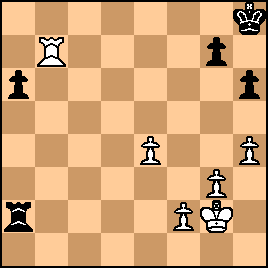
click for larger view"The winning method is limpidly clear: the King must ushered the K side Pawn majority down the board"--(Golombek) "Ensuring that his King will not be restricted to the first rank"--(Terekhov) The computers here all play 38. h5, locking up the King-side. That also works well, but, as Terekhov said: "Smyslov probably did not want to calculate the variations after 38...Ra5 39. g4 [even simpler would have been 39. Rb8+ Kh7 40. f4 Rxh5 41. e5 Kg6 (forced) 41. Rb6+ and 42. Rxa6--KEG] Ra4 42. f3 Ra2 even though White is winning there too." Smyslov, as his various commentaries on this game make clear, saw a straight-forward win with the text and then pursued this line, leaving Reshevsky no way to save the game. The winning procedure, as I will discuss, is beautiful to behold. |
|
Dec-28-24
 | | KEG: Post X
38... a5
"?!--(Terekhov)
"38...h5 would have prevented Smyslov's next move and was thus more tenacious"--(Terekhov) True. I am surprised that none of the other commentators picked up on this. I must confess I initaiily had a hard time proving a win after 38...h5. The game always seemed to reduce to White with Rook and doubled g-pawns against Black's lone Rook; e.g., 38...h5 39. Kf3 Kh7 40 Ke3 a5 41, Ra7 a4 42. f3 Kh8 43. e5 a3 44. Kf4 g6 45. e6 Re2 46. g4 hxg4 47. fxg4 g5+ 48. hxg5+ Kg6 49. e7 a2 50. Rxa2 Rxe7. However, I finally hit on 40. Rb8 Kg6 41. Rf8 Ra3+ 42. Kf4 Ra2 45. Ke3 Rb2 44. f4 Kh7 45. f5, It's tough, but I have finally concluded that Smyslov would still have had the ending under control even after 38...h5 and that Reshevsky didn't miss a way to save the game. In any case, after Reshevsky's actual 38...a5, Smyslov rolled to victory: 39. h5
"!"--(Terekhov)
"Now Black is completely tied down"--(Terekhov)
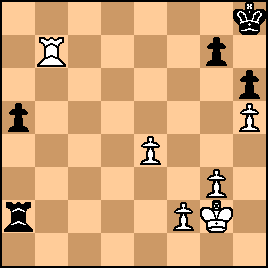
click for larger view39... a4
The a-pawn was Reshsveky's only trump, so he had to try to use it. 40. Ra7
Keres and Terekhov claimed this was a "small inaccuracy" since it allowed the Black King to "get out of the box." However, as Smyslov deftly demonstrated, the text also wins handily, the position now being: 
click for larger view40... Kg8
"The Black king gets out of the corner, but it is still cut off on the last rank and cannot leave g7 unprotected..."--(Terekhov) 41. g4
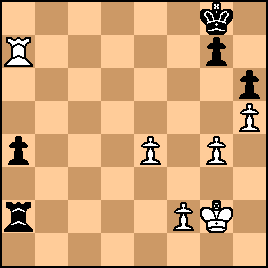
click for larger viewHere Reshevsky sealed his move.
There is an amusing anecdote about what happened when play resumed reported by Kmoch and Horowitz. Reshevsky was surprised at how many people showed up to watch that seemed to be little less than an execution. When Reshevsky mentioned this to Kotov: "Kotov replied that the U.S. champion was famous for his remarkable recoveries [he had saved a piece down ending against Euwe in the previous round--KEG] in critical situations. Sammy sighed: 'This time it is too late for tactical jokes' " 41... a3
The sealed move.
As Golombek noted, Black cannot cut off the White King with 41...Ra3 in light of 42. f3 Rd3 43. Rxa4 Kf7 44. Kg3. Given the foregoing, Golombek stated that:
"Black could quite tranquilly resign."
42. Kg3
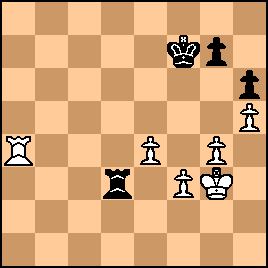
click for larger view"Under the cover of his pawn chain, White's king comes into play"--(Smyslov) 42... Re2
A tricky effort by Reshevsky. Had Smyslov now lost concentration and grabbed the a-pawn, Reshevsky could have drawn after 43...Rxe4. 43. Kf3
Smyslov, of course, did not fall for Reshevsky's little trick, and now was ready to march to victory: 
click for larger view |
|
Dec-28-24
 | | KEG: Post XI
43... Ra2
At this point, Reshevsky must have been playing on momentum rather than on any realistic hope of saving the game. 44. Ke3 Kf8
45. f3
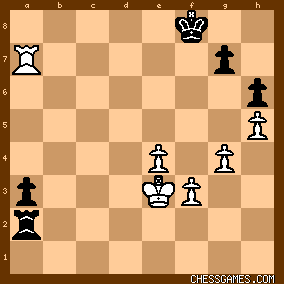
click for larger viewSmyslov was now poised for the kill.
45... Ra1
46. Kf4
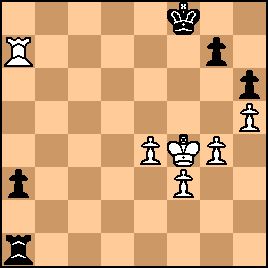
click for larger view"The White King advances towards g6 under cover of the pawn chain. Already Kf5 and f4 is threatened"--(Smyslov) "...the [White] king penetrates into the enemy position"--(Kasparov) 46... a2
"Forced. If Black waits, White wins with 46...Kg8 47. Kf5 Rf1 48. Rxa3 and the [White] Rook protects the f3 pawn"--(Terekhov) 47. e5
"The pawn advance enables the white king to penetrate unhindered to g6"--(Smyslov) 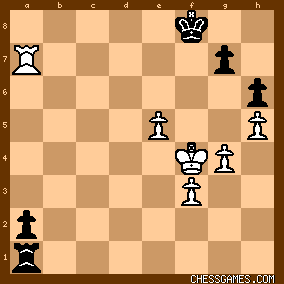
click for larger view47... Kg8
As Kasparov has shown, if instead 47...Ke8 White wins with 48. Kf5 Rf1
49. Rxa2 Rxf3+ 50. Ke6 Kd8 51. Ra7.
48. Kf5
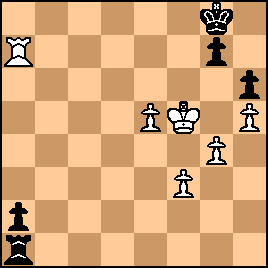
click for larger view48... Rf1
What else?
49. Rxa2 Rxf3+
50. Kg6
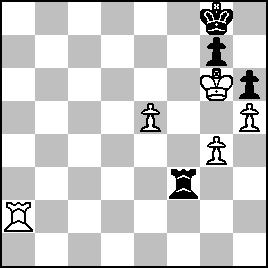
click for larger view50... Kf8
If instead 50...Rf8, White wins with 51. Ra7 (Terekhov) 51. Ra8+ Ke7
52. Ra7+
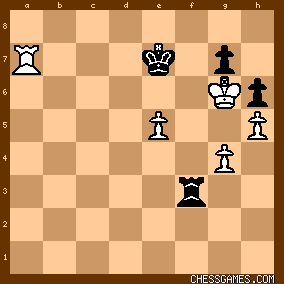
click for larger view1-0
With the g7 pawn about to fall, Black has no reason to play on. A magnificent performance by Smyslov. |
|
 |
|
< Earlier Kibitzing · PAGE 2 OF 2 ·
Later Kibitzing> |
|
|
|





